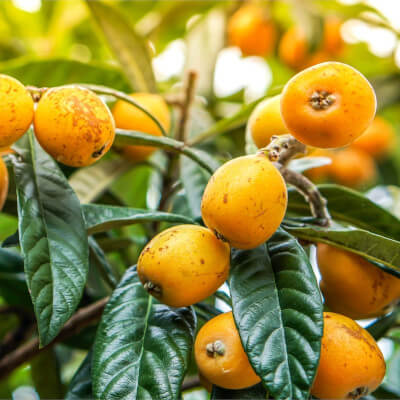
The Japanese loquat (Eriobotrya japonica) stands out as a fascinating fruit tree, both ornamental and practical. Originally from the subtropical regions of China, it has successfully spread to other parts of the world, particularly in Mediterranean, tropical and subtropical climates. Today, it holds a prominent place in many botanical gardens, including the one at the Au Bois Vert restaurant near Ivato and Antananarivo.
This elegant tree makes a striking impression thanks to its evergreen foliage. Its large, leathery leaves with serrated edges can reach up to 30 centimetres in length and are a deep, glossy green. In autumn, the loquat begins to bloom with clusters of small, fragrant white flowers that attract a wide range of pollinators, vital to its life cycle. The show continues into spring, when the tree produces its distinctive fruit — the loquats — which ripen into a vibrant orange hue. These oval-shaped fruits are juicy with a hint of tartness, adding an exotic touch to the gardens they inhabit.
The Eriobotrya japonica, or Japanese loquat, thrives in well-drained soil and sunny conditions. Thanks to its rapid growth and graceful shape, it is an excellent choice for enhancing green spaces in hotels, restaurants, or lodges, particularly in areas such as Antananarivo. In the Au Bois Vert botanical garden, it blends seamlessly into the plant diversity, enriching the landscape with colour, fragrance, and flavour.
More than just a decorative plant, this tree also plays an important ecological role. It provides food and shelter for birds, and its winter blossoms offer a crucial nectar source for bees. With so many qualities, the Japanese loquat is a valuable addition to any outdoor space, whether in a botanical garden or a tourist setting.
Plant use
The Japanese loquat tree is appreciated not only for its ornamental beauty, but also for its many culinary and medicinal uses. In the kitchen, its fruits are enjoyed fresh or turned into compotes, jams, and juices. Rich in vitamins A and C, as well as antioxidants, they are an excellent choice for boosting the immune system and helping to prevent conditions linked to oxidative stress. In some Asian cultures, the seeds and leaves are also used to prepare herbal teas or medicinal extracts. At the Au Bois Vert botanical garden, the Japanese loquat holds a prominent place thanks to its visual appeal and ecological role. Its fruit attracts a variety of wildlife, including birds and small mammals, while its winter blossoms offer a vital source of nectar for bees and other pollinators. For hotels and restaurants around Antananarivo and Ivato, this tree provides a unique opportunity to enhance outdoor spaces while showcasing exotic edible plants. Although not widely used, the wood of Eriobotrya japonica is occasionally employed in artisanal crafts. As a truly versatile species, it is a fine example of how a single tree can enrich both the landscape and the everyday lives of those who live alongside it.
Key information
| Common name | Japanese loquat |
| Scientific name | Eriobotrya japonica |
| Origin | China |
| Natural habitat | Subtropical regions, sunny hills, well-drained soils |
| Life cycle | Perennial |
| Flowering period | Autumn - Winter |


